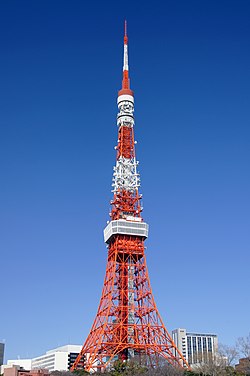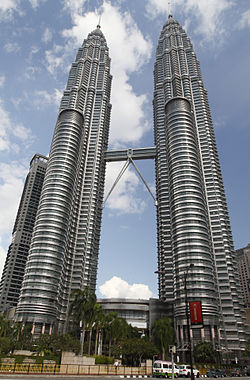List of tallest buildings and structures

Current records by category
This category requires the structure to be "topped out".
Among existing structures
Note: The following table is a list of the tallest completed structure in each of the structural categories below.
Unsurpassed destroyed structures

By function
* "Mixed-use" is defined as having three or more real estate uses (such as retail, office, hotel, etc.) that are physically and functionally integrated in a single property and are mutually supporting.
By continent
Tallest structures on dry land:
History of records
Overall
Tallest structures on dry land:
| Taller than all past structures (including destroyed structures) |
Guyed structures
As many large guyed masts were destroyed at the end of World War II, the dates for the years between 1945 and 1950 may be incorrect. If Wusung Radio Tower survived World War II, it was the tallest guyed structure shortly after World War II.
Freestanding structures
Freestanding structures must not be supported by guy wires (like guyed masts or partially guyed towers), or built underground or on the seabed and supported by the sea (such as the Petronius Platform). They include towers, chimneys, and skyscrapers (listed based on their pinnacle height). Until 1954, freestanding structures held the record for tallest structures overall, as seen in the Overall table above. Here are the records for freestanding structures after that point:

Notable mentions include the Pharos (lighthouse) of Alexandria, built in the third century BC and estimated between 115–135 m (377–443 ft). It was the world's tallest non-pyramidal structure for many centuries. Another notable mention includes the Jetavanaramaya stupa in Anuradhapura, Sri Lanka, which was built in the third century, and was similarly tall at 122 m (400 ft). These were both the world's tallest or second-tallest non-pyramidal structure for over a thousand years.
The tallest secular building between the collapse of the Pharos and the erection of the Washington Monument may have been the Torre del Mangia in Siena, Italy, which is 102 m (335 ft) tall, and was constructed in the first half of the fourteenth century; and the 97-metre-tall (318 ft) Torre degli Asinelli in Bologna, Italy, built between 1109 and 1119.
Freestanding towers

Towers include observation towers, monuments and other structures not generally considered to be "habitable buildings", they are meant for "regular access by humans, but not for living in or office work", meaning it excludes from this list of continuously habitable buildings and skyscrapers. Radio and TV masts with guy-wires for support are also excluded, since they aren't freestanding.
Bridge towers or pylons, chimneys, transmission towers, and most large statues allow human access for maintenance, but not as part of their normal operation, and are therefore not considered to be towers.

The following is a list of structures that have historically held the title as the tallest towers in the world.
Buildings
The Council on Tall Buildings and Urban Habitat, an organization that certifies buildings as the "World's Tallest", recognizes a building only if at least 50% of its height is made up of floor plates containing habitable floor area. Structures that do not meet this criterion, such as the CN Tower, are defined as "towers".
Up until the late 1990s, the definition of "tallest building" was not altogether clear. It was generally understood to be the height of the building to the top of its architectural elements including spires, but not including "temporary" structures (such as antennas or flagpoles), which could be added or changed relatively easily without requiring major changes to the building's design. Varying standards have been used by different organizations, so the accepted height of these structures or buildings depends on which standards are accepted. The Council on Tall Buildings and Urban Habitat has changed its definitions over time. Some of the controversy regarding the definitions and assessment of tall structures and buildings has included the following:
- the definition of a structure, a building and a tower
- whether a structure, building or tower under construction should be included in any assessment
- whether a structure, building or tower has to be officially opened before it is assessed
- whether structures built in and rising above water should have their below-water height included in any assessment.
- whether a structure, building or tower that is guyed is assessed in the same category as self-supporting structures.
Within an accepted definition of a building further controversy has included the following factors:
- whether only habitable height of the building is considered
- whether communication towers with observation galleries should be considered "habitable" in this sense
- whether rooftop antennas, viewing platforms or any other architecture that does not form a habitable floor should be included in the assessment
- whether a floor built at a high level of a telecommunications or viewing tower should change the tower's definition to that of a "building"
One historic case involved the building now famous for the Times Square Ball. Known as One Times Square (at 1475 Broadway in Midtown Manhattan), it was the headquarters for The New York Times, which gave Times Square its name. Completed in 1905, it reached a height of 364 feet (111 meters) to its roof, or 420 feet (130 meters) including its rooftop flagpole, which the Times hoped would give it a record high status but because a flagpole is not an integral architectural part of a building, One Times Square was not generally considered to be taller than the 390-foot-high (120 m) Park Row Building in Lower Manhattan, which was therefore still New York's tallest.
A bigger controversy was the rivalry between two New York City skyscrapers built in the Roaring Twenties—the Chrysler Building and 40 Wall Street. The latter was 927 feet (283 meters) tall, had a shorter pinnacle, and had a much higher top occupied floor (the second category in the 1996 criteria for tallest building). In contrast, the Chrysler Building employed a very long 125-foot (38 m) spire secretly assembled inside the building to claim the title of world's tallest building with a total height of 1,048 feet (319 m), despite having a lower top occupied floor and a shorter height when both buildings' spires are not counted in their heights. Although the architects of record for 40 Wall were H. Craig Severance and Yasuo Matsui, the firm of Shreve & Lamb (who also designed the Empire State Building) served as consulting architects. They wrote a newspaper article claiming that 40 Wall was actually the tallest, since it contained the world's highest usable floor. They pointed out that the observation deck of 40 Wall was nearly 100 feet (30 m) higher than the top floor of the Chrysler, whose surpassing spire was strictly ornamental and essentially inaccessible. Despite the protest, the Chrysler Building was generally accepted as the tallest building in the world for almost a year, until it was surpassed by the Empire State Building's 1,250 feet (380 meters) in 1931.
That was in turn surpassed by the 1,368-foot-high (417 m) Twin Towers of New York's original World Trade Center in 1972, which were in turn surpassed by the Sears Tower in Chicago in 1974. Now called the Willis Tower since 2009, it was 1,451 feet (442 meters) to its flat rooftop, or 1,518 feet (463 meters) including its original antennas. But in 1978 One World Trade Center (commonly known as the North Tower) attained a taller absolute height when it added its 360-foot (110 m) new broadcasting antenna, for a total height of 1,728 feet (526.7 meters). The WTC North Tower maintained this height record (including its antenna) from 1978 until 2000, when the owners of the Willis Tower extended its broadcasting antennae for a total height of 1,729 feet (527.0 meters). Thus the status of the Willis Tower as the "totally" tallest was restored in the face of a new threat looming in the Far East—the "Siamese Twins".

A major controversy erupted upon completion of the Petronas Towers in Kuala Lumpur, Malaysia in 1998. These Twin Towers, at 1,483 feet (452 meters), had a higher architectural height (spires, not antennas), but a lower absolute pinnacle height and a lower top occupied floor than the Willis Tower in Chicago. Counting buildings as structures with floors throughout, and with antenna masts excluded, the Willis was still considered the tallest at that time. Excluding their spires, which are 9 meters (30 feet) higher than the flat roof of Willis, the Petronas Towers are not taller than Willis. At their convention in Chicago, the Council on Tall Buildings and Urban Habitat (CTBUH) found the Willis Tower (without its antennas) to be the third-tallest building, and the Petronas Towers (with their spires) to be the world's two tallest buildings.
Responding to the ensuing controversy, the CTBUH then revised their criteria and defined four categories in which the world's tallest building can be measured, retaining the old criterion of height to architectural top, and adding three new categories:
- Highest occupied floor
- Height to top of roof (omitted from criteria from November 2009 onwards)
- Height to architectural top (including spires and pinnacles, but not antennas, masts or flagpoles). This measurement is the most widely used and is used to define the rankings of the 100 Tallest Buildings in the World.
- Height to tip
The height-to-roof criterion was discontinued because relatively few modern tall buildings possess flat rooftops, making this criterion difficult to determine and measure. The CTBUH has further clarified their definitions of building height, including specific criteria concerning subbasements and ground level entrances (height measured from lowest, significant, open-air, pedestrian entrance rather than from a previously undefined "main entrance"), building completion (must be topped out both structurally and architecturally, fully clad, and able to be occupied), condition of the highest occupied floor (must be continuously used by people living or working and be conditioned, thus including observation decks, but not mechanical floors) and other aspects of tall buildings. The height is measured from the level of the lowest, significant, open-air, pedestrian entrance.
A different superlative for skyscrapers is their number of floors. The original World Trade Center set that record at 110 in the early 1970s, and this was not surpassed until the Burj Khalifa opened in 2010.
Tall freestanding structures such as the CN Tower, the Ostankino Tower and the Oriental Pearl Tower are excluded from these categories because they are not "habitable buildings", which are defined as frame structures made with floors and walls throughout.
Here are the world records by category since the CTBUH defined them in 1996:
| World record at the time | Category omitted by CTBUH in 2009 |
Observation decks
Timeline of development of world's highest observation deck since opening of the Washington Monument in 1888.
Higher observation decks have existed on mountain tops or cliffs, rather than on tall structures. The Grand Canyon Skywalk, constructed in 2007, protrudes 21 m (70 ft) over the west rim of the Grand Canyon and is approximately 1,100 m (3,600 ft) above the Colorado River, making it the highest of these types of structures.
See also
- List of elevator test towers
- List of hyperboloid structures
- List of tallest bridges
- List of tallest church buildings
- List of tallest chimneys
- List of tallest clock towers
- List of tallest cooling towers
- List of tallest dams
- List of tallest educational buildings
- List of tallest freestanding steel structures
- List of tallest hospitals
- List of tallest hotels
- List of tallest minarets
- List of tallest oil platforms
- List of tallest residential buildings
- List of tallest statues
- List of tallest structures built before the 20th century
- List of tallest wooden buildings
- Tallest industrial buildings